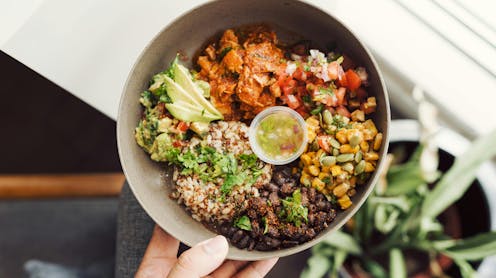Sick of eating the same things? 5 ways to boost your nutrition and keep meals interesting and healthy
- Written by The Conversation

Did you start 2025 with a promise to eat better but didn’t quite get there? Or maybe you want to branch out from making the same meal every week or the same lunch for work almost every day?
Small dietary changes can make a big difference to how you feel, how your body functions and health indicators such as blood pressure, blood sugar and cholesterol levels.
You can meet your nutrient needs by eating a range of foods from the key food groups:
- vegetables and fruit
- protein (legumes, beans, tofu, meats, poultry, fish, eggs, nuts, seeds)
- grains (mostly wholegrain and high-fibre)
- calcium-rich foods (milk, yoghurt, cheese, non-dairy alternatives).
But you also need a variety of foods to get enough vitamins, minerals and phytonutrients from plant foods. Phytonutrients have antioxidant, anti-inflammatory, anti-cancer and other functions that help keep you healthy.
Use these five dietary tweaks to boost your nutrient intake and add variety to what you eat.
1. Include different types of bran to boost your fibre intake
Different types of dietary fibre help improve bowel function through fermentation by gut microbes in the colon, or large bowel. This creates larger, softer bowel motions that then stimulate the colon to contract, leading to more regular bowel movements.
Add different types of dietary fibre – such as oat bran, wheat bran or psyllium husk – to breakfast cereal or add some into recipes that use white flour:
psyllium husk is high in soluble fibre. It dissolves in water forming viscous gel that binds to bile salts, which get excreted and your body is then not able to convert them into cholesterol. This helps lower blood cholesterol levels as well as with retaining water in your colon, making bowel motions softer. Soluble fibre also helps slow the digestive process, making you feel full and slows the normal rise in blood sugar levels after you eat
wheat bran is an insoluble fibre, also called roughage. It adds bulk to bowel motions, which helps keep your bowel function regular
oat bran contains beta-glucan, a soluble fibre, as well as some insoluble fibre.
Try keeping small containers topped up with the different fibres so you don’t forget to add them regularly to your breakfast.
2. Add a different canned bean to your shopping list
Dried beans are a type of legume. From baked beans to red kidney beans and chickpeas, the canned varieties are easy to use and inexpensive. Different colours and varieties have slightly different nutrient and phytonutrient profiles.
Canned beans are very high in total dietary fibre, including soluble fibre and resistant starch, a complex carbohydrate that resists digestion in the small intestine and then passes into the colon where it gets fermented.
The body digests and absorbs the nutrients in legumes slowly, contributing to their low glycemic index. So eating them makes you feel full.
Regularly eating more legumes lowers blood sugar levels, and total and LDL (bad) cholesterol.
Add legumes to dishes such as bolognese, curry, soups and salads (our No Money No Time website has some great recipes).
3. Try a different wholegrain, like buckwheat or 5-grain porridge
Wholegrain products contain all three layers of the grain. Both the inner germ layer and outer bran layer are rich in fibre, vitamins and minerals, while the inner endosperm contains mostly starch (think white flour).
Wholegrains include oats, corn (yes, popcorn too), rye, barley, buckwheat, quinoa, brown rice and foods made with wholegrains, like some breads and breakfast cereals such as rolled oats, muesli and five-grain porridge.
Wholegrains aren’t just breakfast and lunch foods. Dinner recipe ideas include tuna and veggie pasta bake, chicken quesadillas and buckwheat mushroom risotto.
4. Try a different vegetable or salad mix every week
A review of the relationship between plant-based diets and dying of any cause followed more than half a million people across 12 long-term studies.
It found people who ate the most plants had a lower risk of dying during the study and follow-up period than those who ate hardly any.
Try adding a new or different vegetable or salad item to your weekly meals, such as rainbow coleslaw, canned beetroot, raw carrot, red onion, avocado or tomatoes.
Or try a stir-fry with bok choy, celery, capsicum, carrot, zucchini and herbs.
The more variety, the more colour, flavour and textures – not to mention phytonutrients.
5. Go nuts
Cashews, walnuts, almonds, macadamias, pecans and mixed nuts make a great snack.
(Peanuts are technically a legume because they grow in the ground but we count them as nuts because their nutrient profile is very similar to the tree nuts.)
You have to chew nuts well, which means your brain receives messages that you are eating and should expect to soon feel full.
Nuts are energy-dense, due to their high fat content. A matchbox portion size (30 grams) contains about 15 grams of fat, 5 grams of protein and 740 kilojoules.
While some people think you need to avoid nuts to lose weight, a review of energy restricted diets found people who ate nuts lost as much weight as those who didn’t.
My colleagues and I at the University of Newcastle have created a free Healthy Eating Quiz where you can check your diet quality score, see how healthy your usual eating patterns are and how your score compares to others. You can also get some great ideas to make your meals more interesting .







